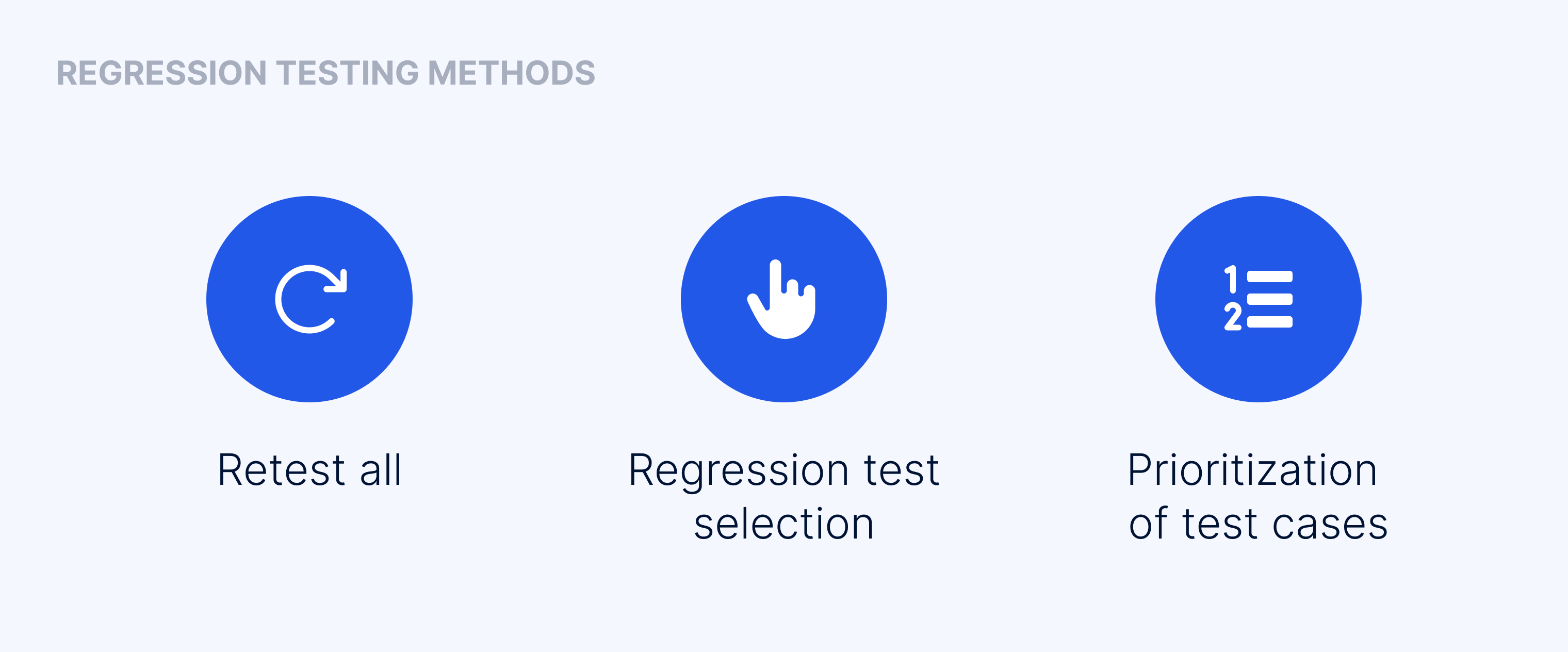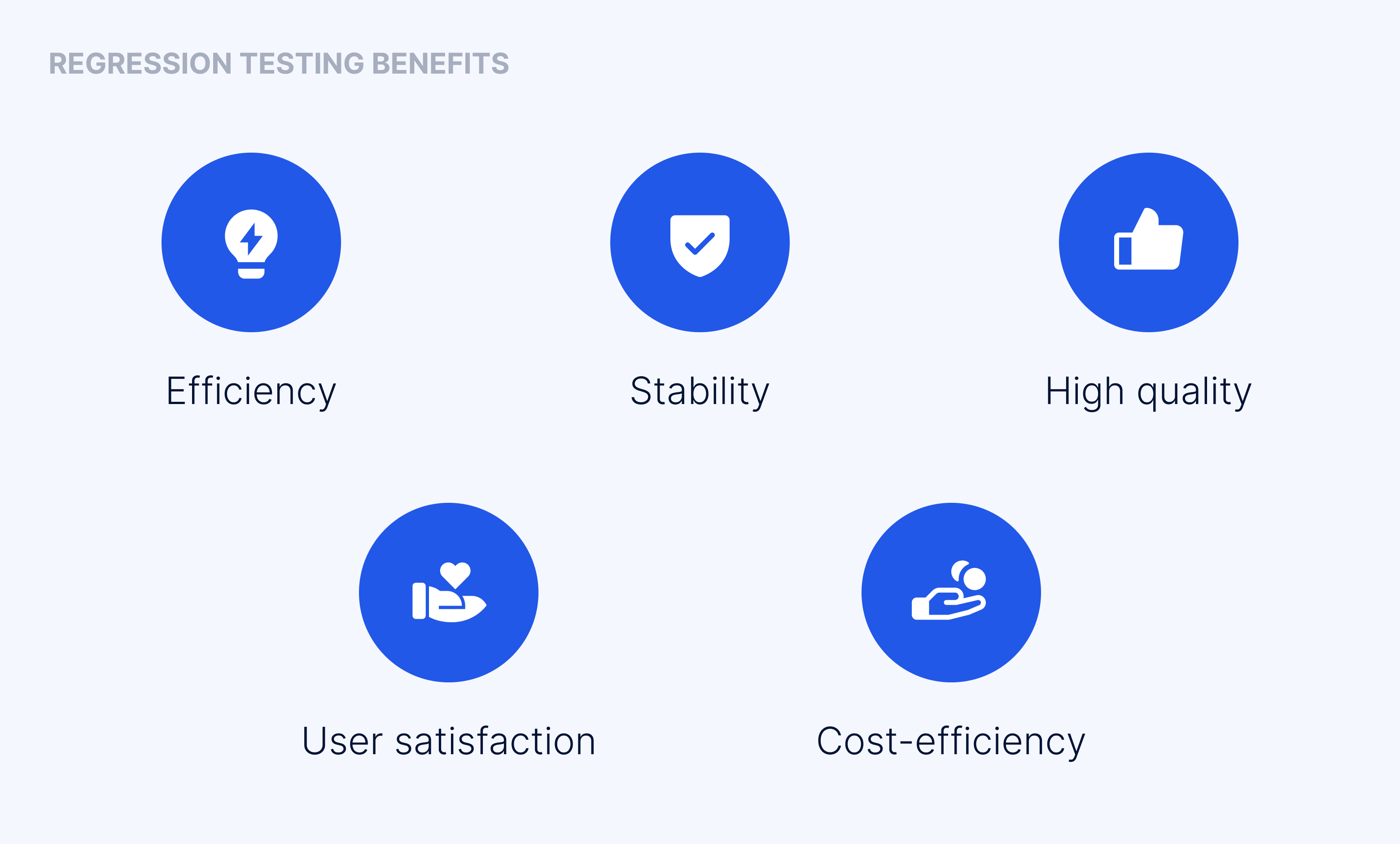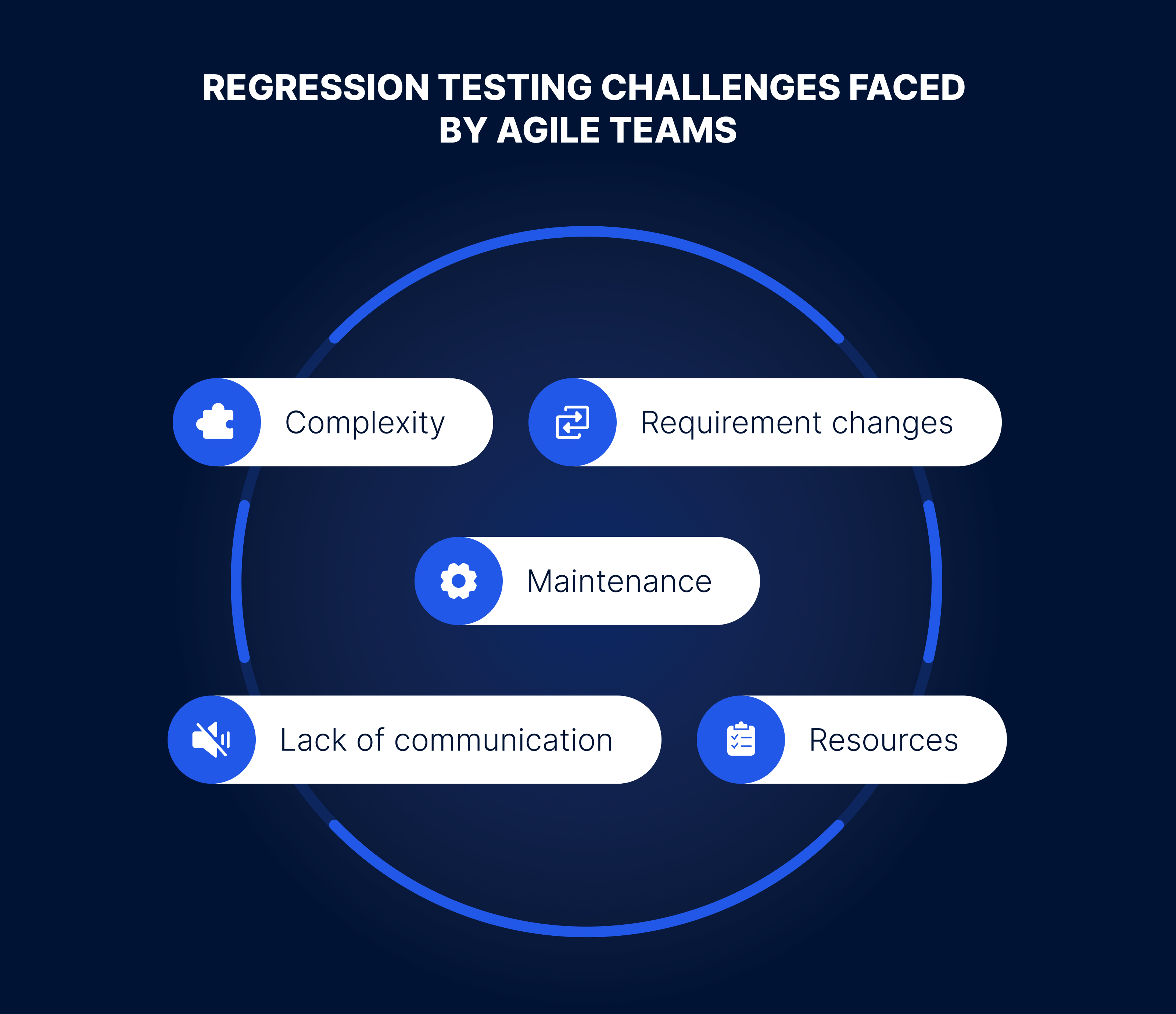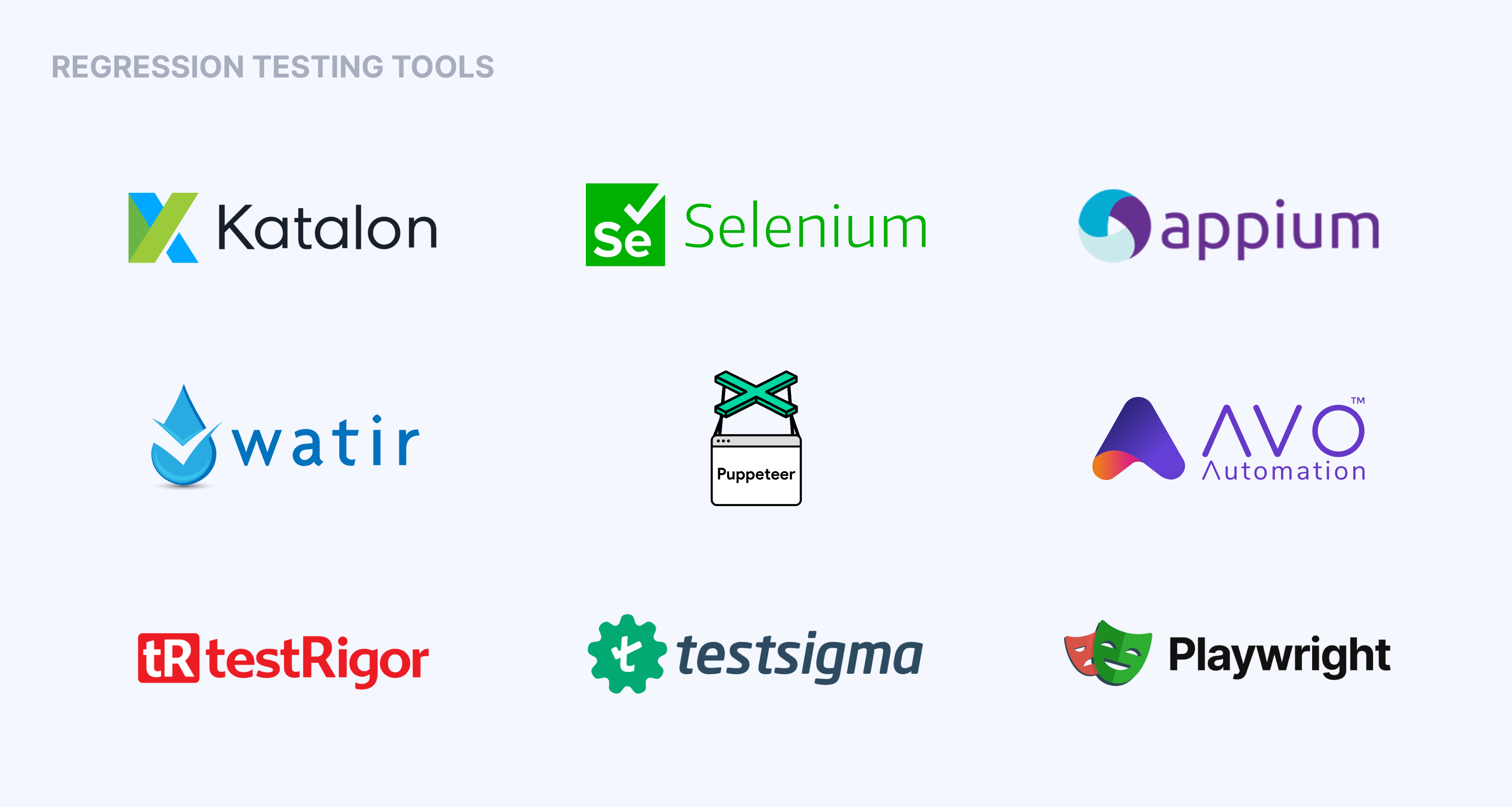
Contact us
Our team would love to hear from you.

Like a tiny spark can start a fire, a small code change can trigger performance degradation. The continuous integration implied by Agile requires constant regression testing to ensure functionality has not been affected. But what is regression testing exactly? Below, we will delve into the definition, methods, benefits, challenges, and strategies of the regression testing undertaken by Agile teams and provide a list of tools designed to streamline the QA process.
The Agile methodology’s incremental and iterative approach implies a continuous updating of source code. The introduction of new code can bring new logic that clashes with existing functionality. This makes regression testing a crucial part of the Agile software development life cycle.
Regression testing is a set of checks conducted after a code update to ensure the changes have not caused defects in the preexisting functionality. In other words, as implied by the name, this type of testing is designed to find and fix regression errors.
As a regression testing example, consider a billing and invoicing platform that offers payment through PayPal. After an update, regression testing would be performed to ensure that new features have not affected the original payment options. Based on the ultimate goal, regression testing can include:
The more frequently you run test cases, the less time-consuming it will be to spot and fix eventual bugs. Regression testing is imperative when:
All these scenarios, except the last one, involve a restructuring or adjustment, which may lead the system to behave in unexpected ways. QA engineers step in to ensure these transitions are implemented successfully.
Various methods are employed in regression testing. Which approach to take depends on the volume of code you need to check, the time available for testing, and, most importantly, the objectives you aim to achieve. The techniques for regression testing include:

There is also a hybrid approach, which is a combination of regression test selection and prioritization of test cases. The difference is that the hybrid method does not involve selecting the entire set of tests; instead, it only performs selected tests based on priority.
Regression testing is vital when making adjustments in software. In the Agile framework, which requires rapid development iterations, this type of quality assurance must be conducted regularly immediately after changes are made.

This approach is essential to address issues promptly and conduct analysis to prevent them from occurring in the future. Regression testing also involves evaluating software for optimization and possible user interface (UI) errors to improve user experience. Regression testing also offers economic advantages stemming from its ability to promptly detect and correct bugs related to functionality, thereby preventing downtime and reducing the time and cost of future releases.
Overall, when properly implemented, regression testing ensures that a system is stable, efficient, functional, and ready for the next enhancements, enabling the Agile team to deliver a high-quality product that meets the needs of end users and businesses alike.
Regression testing plays a crucial role in identifying a range of issues and is essential in ensuring the delivery of a quality product, but it is not without its challenges. QA engineers may encounter the following difficulties when performing regression testing.

Regression testing involves performing the same tests over and over again. When carried out manually, this process can be time-consuming—from a few days for a simpler case to a few weeks for a complex product. Consequently, the overall cost increases due to the need to compensate testers based on their hourly rates.
The more complex the app, the more sophisticated the regression testing process becomes. Testing a sophisticated product may involve checking thousands of functions and testing performance and integration. Therefore, the team needs specialized testing skills, which can also be a challenge.
Regression testing requires modifications to test suites to reflect changes in the project and ensure the cases continue to function as intended.
Effective communication between all team members and stakeholders is crucial for a thorough understanding of the product and the changes it has undergone. Moreover, Agile is all about communication. Close cooperation can provide insight into which functionalities require testing and which no longer need regression testing due to removal or obsolescence.
In Agile, requirements changes are welcome. However, this poses some difficulties for the QA team as these modifications are not always consistent. Any adjustment made requires a revision of the testing strategy.
Smart regression testing planning can help minimize difficulties, if not overcome them entirely. To build a successful regression testing strategy, gather all test cases that must be run, identify potential improvements to the test suites, and estimate the time they will take to complete. In addition, follow these tips:
Write a test plan and continuously update it based on newly identified requirements. This document describes the scope, approach, resources, deadlines, test items, features to test, testing tasks, test environment, and more. It is also crucial in identifying test cases that can be automated in the future. In addition to creating a test plan, work with developers upon the project’s initiation to analyze which modules may be affected by changes so more attention can be devoted to these areas during testing.
Automation is the best way to tackle resource and complexity issues and improve the accuracy and consistency of test results.
The first benefit of automation is the exclusion of the “human factor” since all written tests are executed automatically, whereas with manual testing, an engineer may inadvertently miss a test.
Second, repetitive testing can cause testers to become fatigued and lose motivation, which affects the quality of the work. Automated testing is the ideal solution to this problem. Moreover, automated regression testing enables engineers to free up time for more difficult tests.
Third, compared to manual scripts, automated scripts require less time for maintenance and results analysis. Furthermore, reports are automatically generated, distributed, and saved.
However, while automation is beneficial, it is not a silver bullet, and some test cases could show false results. For this reason, results must be verified by human testers.
Another method of saving time and expediting regression testing is test case prioritization, which provides a clear understanding of the importance of each test and eliminates those that are redundant. Prioritization involves assessing the code coverage of test cases, identifying potential problem areas, considering the recently updated portion of the program, and analyzing requirements to determine the most critical test cases that should be executed first.
Regression testing cases must be constantly updated to ensure their relevance, accuracy, and effectiveness. Testing suites developed for the first version of software may not be suitable for the same app after it has been enhanced with new functionality, interface, and code. If not updated along with the software, test cases can show false positive results, miss critical issues, and result in wasted time and money.
There is a wide range of regression testing tools, each with its own package of features. Which tool to use is determined by its popularity in a certain region, the set of functions it offers, and the personal preferences of experts. Below, we list some of the most relevant and consistently updated solutions that we have hands-on experience with.

This is a free, web-based automation testing tool that allows engineers to execute scripts in different contexts, browsers, and devices. Katalon Studio offers customizable test reports, allowing testers to thoroughly assess results and share them with stakeholders in LOG, HTML, CSV, and PDF formats.
One of the best tools for cross-platform and cross-browser regression testing, Selenium is a web app solution that supports data-driven testing and automated test scripts and is compatible with many programming languages, frameworks, and libraries.
Watir is an open-source tool for automating web app testing with Ruby libraries. This solution is distinguished by its lightweight and adaptable user interface, which simplifies test development and management. Watir provides several features that enable user interaction with the system, including following links, filling out forms, and checking texts in multiple browsers.
TestSigma is a scriptless regression testing tool that suggests relevant and/or affected test cases after a bug fix or code change. One of its advantages is the ability to run a test right after the first registration in a sprint.
TestRigor is designed to enable team-wide testing. With this tool, engineers can create test scripts in English without coding, which allows users of all technical abilities to quickly and efficiently create end-to-end tests of any complexity.
Avo Assure is an easy-to-use, technology-agnostic, and code-free test automation tool that helps execute end-to-end testing of business apps, including web, desktop, and mobile solutions.
This is an open-source tool designed to automate testing regardless of software type. Engineers use Appium for testing on all platforms, be it native or cross-platform, mobile or web solution. It supports a variety of languages, including Java, JavaScript, Python, Ruby, and C#.
This is a cross-browser, cross-platform, and cross-language solution for end-to-end testing. Though it was only released in 2020, Playwright has already gained popularity among QA engineers, who leverage the library’s capabilities to create robust and reliable end-to-end tests.
Puppeteer is a Node.js library that can be used both for web scraping and testing automation. This easy-to-use, fast, and feature-rich tool offers a clean syntax to create understandable tests and facilitate the testing workflow.
Regression testing is a vital part of Agile software development. Just as humans must undergo regular health checks so as not to miss evidence of disease, software must be tested after each iteration to ensure the system’s functionality has not been compromised.
By embracing regression testing to align existing and updated functionalities, a team can quickly and efficiently address any potential bugs, ensuring the delivery of high-quality software and alleviating the need for possible rework in the future. With EffectiveSoft’s tech-savvy engineers, you can be confident that your solution will undergo comprehensive testing and be aligned with the evolving demands of the market. Contact us to learn more about our QA services.
Our team would love to hear from you.
Fill out the form, and we’ve got you covered.
What happens next?
San Diego, California
4445 Eastgate Mall, Suite 200
92121, 1-800-288-9659
San Francisco, California
50 California St #1500
94111, 1-800-288-9659
Pittsburgh, Pennsylvania
One Oxford Centre, 500 Grant St Suite 2900
15219, 1-800-288-9659
Durham, North Carolina
RTP Meridian, 2530 Meridian Pkwy Suite 300
27713, 1-800-288-9659
San Jose, Costa Rica
C. 118B, Trejos Montealegre
10203, 1-800-288-9659